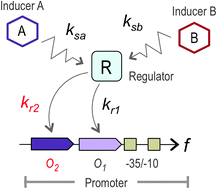Mol Biosyst. 2012 Jul 6;8(7):1950-7
Silva-Rocha R, de Lorenzo V.
 In this report, we experimentally demonstrate that improving the cis-regulatory
region of a target promoter can significantly enhance the response to
an otherwise poor inducer. The transcriptional factor (TF) BenR of Pseudomonas putida KT2440 is a member of the AraC/XylS family that activates the Pb promoter in response to benzoate. This TF can also trigger Pb
activity in response to 3-methylbenzoate (3MBz), but with lower
efficiency. Unlike other family members, BenR appears to recognize one
operator partially overlapping the −35 promoter region and which is
followed by an upstream DNA sequence that lacks an essential motif for
TF binding. By generating a promoter variant composed of two complete
operator sequences, we observed an enhancement in the sensitivity of Pb
to the two inducers. This effect was more pronounced in the case of
3MBz, for which the transcriptional response was approximately 4–5 times
higher with the variant than with the wild type promoter.
In this report, we experimentally demonstrate that improving the cis-regulatory
region of a target promoter can significantly enhance the response to
an otherwise poor inducer. The transcriptional factor (TF) BenR of Pseudomonas putida KT2440 is a member of the AraC/XylS family that activates the Pb promoter in response to benzoate. This TF can also trigger Pb
activity in response to 3-methylbenzoate (3MBz), but with lower
efficiency. Unlike other family members, BenR appears to recognize one
operator partially overlapping the −35 promoter region and which is
followed by an upstream DNA sequence that lacks an essential motif for
TF binding. By generating a promoter variant composed of two complete
operator sequences, we observed an enhancement in the sensitivity of Pb
to the two inducers. This effect was more pronounced in the case of
3MBz, for which the transcriptional response was approximately 4–5 times
higher with the variant than with the wild type promoter.
By comparing
the responses of the promoters to different concentrations of the
inducers, we observed that the modification of the BenR binding region
changes the inherent logic of Pb from an amplifier-like
behaviour, in which benzoate acts as the sole input, towards OR-gate
behaviour, in which 3MBz acts as a second input. Using a mathematical
model, we deduced that the second binding site engineered in the Pb
promoter enhances the activity of BenR that is bound to the natural
operator region, increasing the inducing sensitivity. This work
demonstrates how the promiscuity or specificity of inducer recognition
can be tuned in a regulatory network without TF mutation and suggests
new strategies for the engineering of logic operations in living systems.

